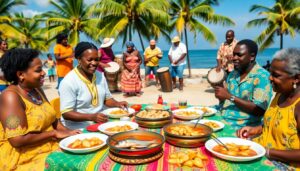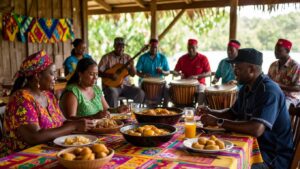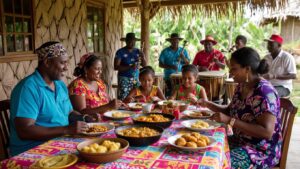Unveiling the Depths of Garifuna Culture in Belize: Celebrating Heritage, Culinary Treasures & Unique Experiences
The Garifuna people of Belize represent a vibrant fusion of African, Indigenous Caribbean, and European cultural influences, resulting in a distinct cultural heritage that is celebrated globally and recognized by UNESCO. Their extensive traditions encompass various aspects, including language, music, culinary arts, dance, spirituality, and an unwavering sense of community. This comprehensive guide invites you to explore the captivating narrative of the Garifuna in Belize, delving into their history, traditions, festivals, cuisine, and the vibrant cultural heart of Hopkins Village.
Exploring the Rich Historical Heritage of the Garifuna
As one of the most distinguished cultural groups in Belize, the Garifuna trace their ancestry back to West and Central African ancestors along with the Indigenous Caribs and Arawaks. Following their fierce resistance to colonial rule in St. Vincent in 1797, they faced exile to Central America. Today, the Garifuna population in Belize comprises roughly 30,000 individuals, significantly enriching the cultural landscape of southern Belize with their unique language, exquisite cuisine, vibrant art, and rich customs. Recognized by UNESCO as a Masterpiece of the Oral and Intangible Heritage of Humanity, their enduring spirit, creativity, and adaptability continue to shine in communities like Dangriga, Hopkins, Seine Bight, and Punta Gorda, as well as in diaspora communities across the Americas. The annual celebration of Garifuna Settlement Day on November 19th serves to highlight their remarkable journey of resilience, community, and rich cultural traditions.

Unearthing the Historical Roots of the Garifuna Community
Tracing the Ancestry of African and Carib Heritage
The narrative of the Garifuna people begins in the 17th century with the remarkable union of African survivors from two Spanish slave ships and the Indigenous Carib and Arawak inhabitants of St. Vincent in the Lesser Antilles. Over more than 150 years, intermarriage and cultural exchange cultivated a unique Afro-Indigenous identity known as the Garinagu. This identity is characterized by a rich tapestry of traditions, languages, and practices that reflect their diverse ancestral backgrounds, showcasing a deep connection to both the land and the sea.
Forced Exile and New Beginnings in Belize: A Journey of Resilience
In 1797, after fierce resistance to British colonial forces, approximately 5,000 Garifuna were forcibly exiled from St. Vincent to Roatán, Honduras. This marked the beginning of migrations that spread along the Central American coastline. By the early 19th century, vibrant Garifuna communities had established themselves in southern Belize, particularly in culturally rich areas like Dangriga, known as the cultural capital, as well as in Hopkins, Seine Bight, and Barranco. British authorities supported these migrations, seeking skilled laborers proficient in fishing and agriculture, which facilitated the growth of these communities and helped preserve their unique cultural identity.
Resilience and Cultural Continuity Amidst Challenges
Despite numerous challenges posed by European colonization, land dispossession, and systemic discrimination, the Garifuna have successfully preserved their language, social institutions, and vibrant religious traditions. The establishment of the National Garifuna Council in 1981 has been instrumental in advocating for cultural rights and education, ensuring that the Garifuna heritage is celebrated and recognized both locally and internationally.
The Importance of Language and Identity in the Garifuna Community
The Distinctive Characteristics of the Garifuna Language
The Garifuna language is an Arawakan language notable for its incorporation of Carib and African loanwords, making it a remarkable example among Central American languages. It features gendered pronouns, a sophisticated tense system, and a rich wealth of oral traditions that reflect the community's history and cultural values. However, the survival of the Garifuna language is currently threatened by a language shift due to migration and urbanization, with fewer than 15,000 Belizean Garifuna individuals remaining fully fluent in their mother tongue.
Efforts for Revitalization and Preservation of the Garifuna Language
The recognition of the Garifuna language and music as an Intangible Heritage by UNESCO in 2001 has sparked revitalization efforts. In communities such as Hopkins and Dangriga, primary schools have begun offering educational programs in Garifuna, while community radio stations broadcast music and news in the language, effectively preserving its vibrancy. Organizations like GAMAE International have initiated language immersion summer camps aimed at reconnecting youth with their ancestral roots and linguistic heritage, fostering a sense of pride and identity.
Expressions of Identity and Global Diaspora Connections
The Garifuna identity is strengthened through traditional attire, ancestral lineage, clan totems, and unique naming practices. This identity is actively nurtured by cultural associations both within Belize and in diaspora communities located in major cities such as New York, Los Angeles, and London, where they continue to celebrate their rich heritage through various cultural events and gatherings.
The Dynamic Realm of Garifuna Music and Dance
Intricate Rhythms and Spiritual Significance of Garifuna Music
Garifuna music is characterized by its intricate rhythmic patterns, blending traditional African polyrhythms with Indigenous chants. Central to many spiritual rituals and celebrations, the drums—specifically the primero (tenor) and segunda (bass)—play a pivotal role in expressing the community's cultural identity. The sacred dugú ceremony, for instance, involves drum circles and ancestral invocations aimed at healing or blessing families, illustrating the deep connection between music and spirituality in Garifuna culture.
Celebrating Garifuna Dance Forms: Punta and Punta Rock
Among the most celebrated Garifuna dance forms is the punta, characterized by rapid hip movements and intricate footwork, often accompanied by call-and-response singing and vibrant percussion. The contemporary evolution of this dance style, known as punta rock, has been popularized by renowned musicians such as Andy Palacio and Pen Cayetano, who blend traditional rhythms with modern instrumentation, successfully spreading Garifuna culture to audiences worldwide.
Festivals and Community Celebrations: A Living Cultural Showcase
In the vibrant towns of Hopkins and Dangriga, dance troupes regularly perform during cultural festivals and for visiting tourists, creating a living connection between generations. These performances not only celebrate Garifuna heritage but also serve as an important economic resource for the community, fostering tourism and cultural exchange that enriches both visitors and locals alike.

Understanding Garifuna Cultural Practices and Spiritual Beliefs
The Profound Significance of the Dugú Ceremony
The dugú ceremony is a multi-day event where extended families gather to pay homage to the spirits of their ancestors, referred to as gubida. Guided by a spiritual healer, or buyei, the ceremony encompasses music, dance, and communal feasting, all aimed at restoring harmony within families and the broader community. It emphasizes a profound respect for the land, ancestral heritage, and collective responsibilities, reinforcing the Garifuna's deep-rooted connection to their cultural identity.
Everyday Life and Spiritual Beliefs: A Harmonious Blend
The spiritual beliefs of the Garifuna represent a unique fusion of Catholicism along with African and Arawak cosmologies. Daily life is punctuated by various rituals, which include blessing new buildings, rites of passage for births and deaths, and agricultural celebrations. Important symbols, such as the conch shell, sea turtle, and cassava, serve as vital connections between households, the natural world, and the ancestral spirits, reflecting the community's reverence for their cultural heritage.
Diving into Garifuna Cuisine and Culinary Traditions
Exploring Culinary Staples and Signature Dishes of Garifuna Culture
The culinary landscape of Garifuna culture is deeply rooted in staples such as cassava (or yuca), plantains, coconut, and fresh seafood. Among traditional offerings, ereba stands out as a cassava bread made from grated cassava that is pressed and toasted over an open fire. Another signature dish, hudut, features fish cooked in creamy coconut milk, served alongside mashed green and ripe plantains. Other popular dishes include machuca, a hearty fish soup with garlicky, mashed plantain dumplings, and tapou, a savory coconut milk seafood stew. In bustling street markets in Hopkins and Dangriga, visitors can indulge in local delights such as cassava pone (a sweet cake), fried plantain balls (known as ganún), and refreshing conch ceviche, which showcases the vibrant flavors of Garifuna culinary traditions.
Promoting Sustainable Food Practices within the Garifuna Community
Traditional Garifuna practices such as seasonal fishing, shellfish gathering, and small-scale gardening promote ecological stewardship and sustainability. These practices are guided by cultural taboos and principles of communal resource management. Culinary festivals held in Hopkins showcase cooking contests and food tours facilitated by women’s cooperatives, ensuring the preservation of recipes and culinary techniques while engaging visitors in the rich gastronomic heritage of the Garifuna community.
Hopkins Village: The Cultural Epicenter of Garifuna Life
Historical Background and Cultural Significance of Hopkins
Founded in the early 1800s and known as Yarumein in Garifuna, Hopkins is nestled along the picturesque Stann Creek coast. It serves as a pivotal center for the Garifuna language, music, and crafts, embodying the rich cultural legacy of the community and acting as a beacon for cultural preservation.
Essential Experiences to Enjoy in Hopkins
- Drum Circles: Participate in daily drum schools and enjoy nightly drum circles at local cultural centers, immersing yourself in the rhythmic heart of Garifuna music.
- Garifuna Museum: Explore artifacts, oral histories, and photographic archives that delve into migration, language, and music, providing a deeper understanding of Garifuna culture.
- Homestays and Workshops: Engage with local families who offer cooking lessons, fishing trips, and demonstrations of cassava bread making, allowing for a personal connection to the culture.
Annual cultural events in Hopkins, particularly the youth pageants during Garifuna Settlement Day, position the village as an authentic gateway to experiencing the rich cultural tapestry of Garifuna Belize.
The Economic Impact of Cultural Tourism in Hopkins
Cultural tourism plays a vital role in Hopkins, supporting over 75% of local households through guest accommodations, handicrafts, music classes, and guided tours. The headquarters of the National Garifuna Council coordinates regional festivals and advocacy initiatives, ensuring that Garifuna culture remains dynamic and visible to the world, benefiting both the local economy and the preservation of cultural identity.
Celebrating Garifuna Settlement Day: A Vibrant Cultural Commemoration
The Historical Importance of Settlement Day
Celebrated each November 19 since 1941 and nationally recognized since 1977, Garifuna Settlement Day commemorates the momentous arrival of Garifuna ancestors in Belize by canoe in 1802. The reenactment procession known as Yurumein showcases villagers carrying drums, cassava, and crops amidst joyous singing and prayer, symbolizing their enduring legacy and cultural continuity.
Modern-Day Celebrations: A Fusion of Heritage and Festivity
The festivities of Garifuna Settlement Day beautifully blend sacred and secular elements, featuring nightlong dugú ceremonies and all-day drumming in churches and community squares. Processions adorned in traditional attire, lively parades, dance performances, and food fairs mark the day, inviting community members and visitors to partake in the celebrations. National broadcasts, media features, and diaspora celebrations in major US cities attract visitors from throughout Belize and beyond, enhancing awareness and appreciation for Garifuna cultural traditions.
Addressing Contemporary Challenges in Preserving Cultural Heritage
The Language Shift and Its Impact on the Youth
Language shift poses a critical threat to the Garifuna community, as many young people, particularly in urban environments, are increasingly speaking English or Kriol at home. UNESCO has recognized this concerning trend, prompting schools and NGOs to implement language immersion programs, radio broadcasts, and mentorship initiatives aimed at preserving linguistic heritage and cultural identity among the youth.
Land Rights Concerns and Tourism Development Challenges
The rapid expansion of tourism and real estate development in coastal regions such as Seine Bight and Hopkins jeopardizes the traditional landholdings of the Garifuna. Advocacy from the National Garifuna Council and collaborative NGOs focuses on securing land rights, influencing urban planning, and ensuring that tourism revenues benefit local families and communities, thereby safeguarding their cultural heritage.
Engaging Youth through Arts, Technology, and Diaspora Connections
Garifuna artists and musicians, both locally and in the diaspora, are actively recording music, documenting recipes, and preserving oral histories to create digital archives and virtual festivals. These modern platforms are crucial in fostering connections between the broader Garifuna community and younger generations, ensuring that their rich cultural heritage is maintained and celebrated in an increasingly digital world.
Guidelines for Experiencing Garifuna Culture Responsibly and Respectfully
- Choose accommodations in Hopkins, Dangriga, or Seine Bight, and book tours directly with Garifuna-owned businesses to support the local economy and cultural preservation.
- Participate in a drum workshop, attend a Settlement Day celebration, or volunteer in local cultural preservation initiatives to immerse yourself in the vibrant culture.
- Support women’s cooperatives by sampling traditional dishes or purchasing handcrafted items, promoting sustainable livelihoods and empowering local artisans.
- Always respect local customs; seek permission before taking photographs of individuals, and be mindful during rituals and ceremonies to honor their cultural significance.
- Learn a few basic words in the Garifuna language to demonstrate your respect and genuine curiosity for the culture, enhancing your overall experience.
The richness of Garifuna culture in Belize embodies a vibrant tapestry of resilience, deep spirituality, infectious music, delectable culinary offerings, and strong community ties. By visiting places like Hopkins or Dangriga, participating in local festivals, or immersing oneself in the rhythmic heartbeat of the drums, travelers are provided with a unique opportunity to engage with a rich historical continuum where the past and present resonate together. Supporting businesses owned by the Garifuna, honoring their traditions, and celebrating the linguistic and culinary diversity of this remarkable culture are essential steps to ensure its survival and flourishing for generations to come.
References and Further Reading on Garifuna Culture
- Language, Dance, and Music of the Garifuna – UNESCO Intangible Heritage
- History Of The Garifuna People – Belize.com
- Garifuna People – Wikipedia
- Varner, G.R. “Native Status and Maya Identity in Belize.” Journal of Latin American Anthropology, 1998
- Lee, N.R. “Toledo Garifuna and Indigenous Rights.” Mesoamerican Research, 2022
- National Garifuna Council – Wikipedia
- The Garifuna Living Heritage – ICH NGO Forum, 2023
- Dinther, R. “Language Shift and Prestige: Garifuna in Hopkins.” Journal of Pidgin and Creole Languages, 2017
- Habinaha Garifuna Language Program
- Veal, T. “Africanisms in Garifuna Culture of Belize.” Cultural Anthropology, 2004
- National Geographic: Preserving Garifuna Identity Through Ritual
- Music In Africa: Punta Rock and Garifuna Music
- Hopkins Cultural Center Official Site
- Cultural Survival Quarterly: Maya Rainforest and Garifuna in Belize
- Belize Living Heritage: Rituals and Social Practices
- Texas A&M: Belizean Food Culture
- Love Your Belize: Hudut Recipe
- Global M&A Pages: Sustainable Fishing Cooperatives
- National Garifuna Council of Belize
- UN Sustainable Development Reports on Garifuna Cultural Tourism
- Ambergris Caye: Garifuna Settlement Day Celebrations
- Garifuna.com: Diaspora, Digital Storytelling, and Modern Initiatives
The Article Garifuna Culture in Belize: Heritage, Food & Where to Experience It appeared first on Belize Travel Guide
The Article Garifuna Culture: Experience Heritage and Cuisine in Belize Was Found On https://limitsofstrategy.com


